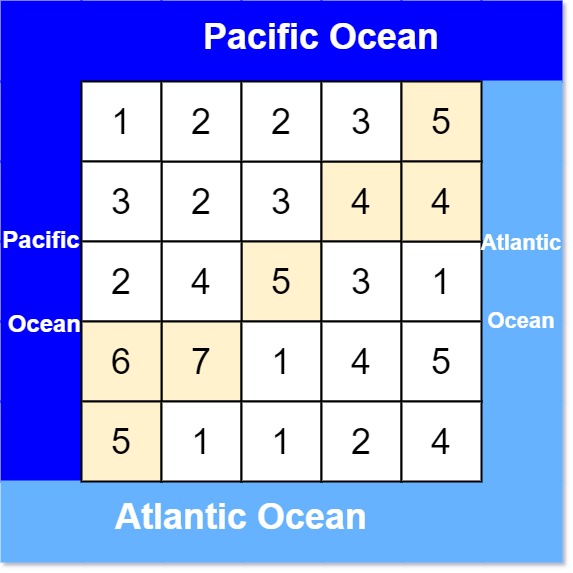29. Pacific Atlantic Water Flow
Problem Statement
There is an m x n rectangular island that borders both the Pacific Ocean and the Atlantic Ocean. The Pacific Ocean touches the island's left and top edges, and the Atlantic Ocean touches the island's right and bottom edges.
The island is partitioned into a grid of square cells. You are given an m x n integer matrix heights where heights[r][c] represents the height above sea level of the cell at coordinate (r, c).
The island receives a lot of rain, and the rain water can flow to neighboring cells directly north, south, east, and west if the neighboring cell's height is less than or equal to the current cell's height. Water can flow from any cell adjacent to an ocean into the ocean.
Return a 2D list of grid coordinates result where result[i] = [ri, ci] denotes that rain water can flow from cell (ri, ci) to both the Pacific and Atlantic oceans.
Example 1:

Input: heights = [[1,2,2,3,5],[3,2,3,4,4],[2,4,5,3,1],[6,7,1,4,5],[5,1,1,2,4]] Output: [[0,4],[1,3],[1,4],[2,2],[3,0],[3,1],[4,0]]
Example 2:
Input: heights = [[1]] Output: [[0,0]]
Solution
class Solution:
def pacificAtlantic(self, heights: list[list[int]]) -> list[list[int]]:
if not heights:
return []
m, n = len(heights), len(heights[0])
pacific_reachable = set()
atlantic_reachable = set()
def dfs(r, c, reachable_set, prev_height):
# Check boundaries, if already visited, or if water cannot flow up
if (
r < 0 or r >= m or c < 0 or c >= n
or (r, c) in reachable_set
or heights[r][c] < prev_height
):
return
reachable_set.add((r, c))
# Explore neighbors
dfs(r + 1, c, reachable_set, heights[r][c])
dfs(r - 1, c, reachable_set, heights[r][c])
dfs(r, c + 1, reachable_set, heights[r][c])
dfs(r, c - 1, reachable_set, heights[r][c])
# Start DFS from all cells bordering the Pacific Ocean
for r in range(m):
dfs(r, 0, pacific_reachable, 0)
for c in range(n):
dfs(0, c, pacific_reachable, 0)
# Start DFS from all cells bordering the Atlantic Ocean
for r in range(m):
dfs(r, n - 1, atlantic_reachable, 0)
for c in range(n):
dfs(m - 1, c, atlantic_reachable, 0)
# The result is the intersection of the two sets
return list(pacific_reachable.intersection(atlantic_reachable))
Explanation
Instead of trying to trace the path of water from every cell to the oceans, it's much more efficient to start from the oceans and see which cells the water can reach.
The core idea is to find all cells that can flow to the Pacific and all cells that can flow to the Atlantic. The answer is the intersection of these two sets.
-
Start from the Oceans: We can think of this as water flowing "uphill" from the oceans. A cell
(r, c)can be reached from an ocean if its height is greater than or equal to the height of the cell from which the water is coming. -
Two Reachable Sets: We use two sets,
pacific_reachableandatlantic_reachable, to store the coordinates of the cells that can be reached by each ocean. -
DFS from Borders:
- We perform a DFS starting from all the cells on the Pacific border (top and left edges). The
dfsfunction explores all reachable cells from a starting point, adding them to thepacific_reachableset. - Similarly, we perform another DFS starting from all the cells on the Atlantic border (bottom and right edges), adding reachable cells to the
atlantic_reachableset.
- We perform a DFS starting from all the cells on the Pacific border (top and left edges). The
-
DFS Logic: The
dfsfunction takes the current cell(r, c), the appropriatereachable_set, and theprev_height. It only continues the search if the current cell is within bounds, hasn't been visited yet, and its height is greater than or equal to theprev_height(allowing water to flow "uphill"). -
Intersection: Finally, the cells that can reach both oceans are the ones present in both sets. We find the intersection of
pacific_reachableandatlantic_reachableto get our final result.
The time complexity is O(m * n) because we visit each cell at most twice (once for the Pacific DFS and once for the Atlantic DFS). The space complexity is also O(m * n) for the recursion stack and the reachable sets.